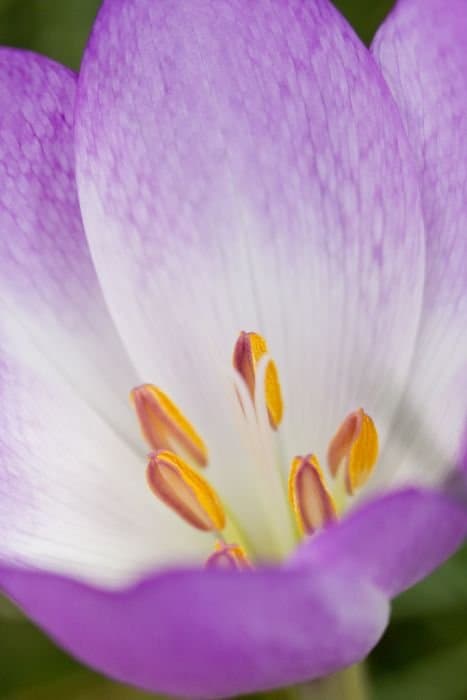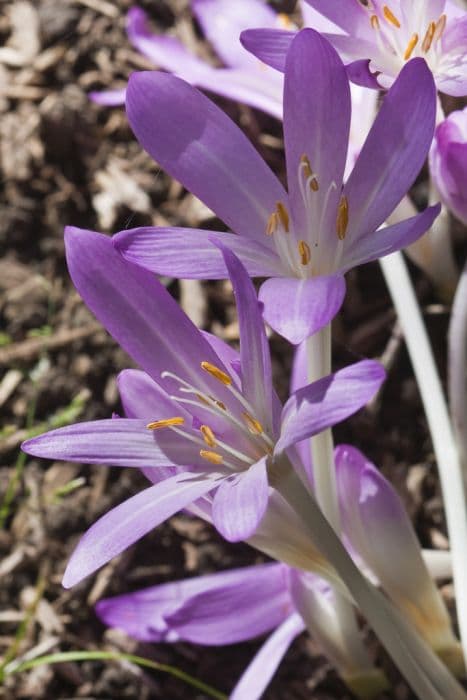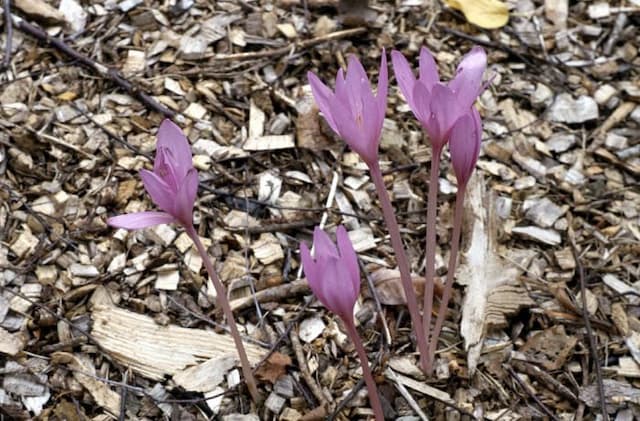Autumn Crocus Colchicum 'Pink Goblet'

ABOUT
Colchicum 'Pink Goblet' is a plant distinguished by its striking floral display resembling large, goblet-shaped flowers. These blooms have a subtle pink hue, often appearing with a soft, pastel tone that can range from almost white to a more pronounced pink depending on the individual flower. The petals are elongated and typically have a gentle taper, converging at the end to form the characteristic goblet shape. Each flower comprises numerous petals that overlap, adding to the robustness of the bloom. The center of the flowers houses prominent, contrasting stamens that can catch the eye amidst the gentle pink petals. The foliage of this plant is also noteworthy, emerging after the flowering period. The leaves are typically a lush green in color, broad and strap-like with a smooth texture that complements the blooms, adding to the overall aesthetic of the plant. The appearance of Colchicum 'Pink Goblet' is emblematic of the fall season when it usually blooms, bringing a splash of fresh color to gardens as many other plants are starting to fade.
About this plant
 Names
NamesFamily
Colchicaceae
Synonyms
Autumn Crocus, Meadow Saffron, Naked Lady
Common names
Colchicum 'Pink Goblet'.
 Toxicity
ToxicityTo humans
Autumn crocus contains highly toxic alkaloids, particularly colchicine. If ingested, even in small amounts, it can cause severe symptoms which may include gastrointestinal distress (nausea, vomiting, diarrhea), abdominal pain, kidney failure, and as poisoning progresses, it may lead to more severe issues such as multi-organ failure or cardiovascular collapse. Symptoms can be delayed for several hours, and ingestion can be fatal, so immediate medical attention is crucial.
To pets
Autumn crocus is highly toxic to pets due to the presence of colchicine. Ingestion can lead to serious symptoms such as gastrointestinal upset (vomiting, diarrhea), severe drooling, abdominal pain, liver and kidney damage, respiratory failure, seizures, and possibly death. Symptoms might take hours to appear and often become progressively worse. It is critical to seek veterinary care immediately if ingestion is suspected.
 Characteristics
CharacteristicsLife cycle
Perennials
Foliage type
Deciduous
Color of leaves
Green
Flower color
Pink
Height
6 inches (15 cm)
Spread
3 inches (7.6 cm)
Plant type
Bulb
Hardiness zones
4
Native area
Mediterranean
Benefits
 General Benefits
General Benefits- Ornamental Appeal: The Colchicum 'Pink Goblet', commonly known as Autumn Crocus, has striking pink flowers that add beauty and visual interest to autumn gardens.
- Easy to Grow: Autumn Crocus is known for being low-maintenance and easy to cultivate, making it suitable for gardeners of all skill levels.
- Naturalizing: Over time, this plant can spread and naturalize in an area, creating a larger display without requiring additional planting.
- Late Blooming: As an autumn-blooming plant, it provides color and interest in the garden at a time when many other plants are fading or have finished blooming.
- Drought Tolerance: Once established, Autumn Crocus is quite drought-tolerant, requiring minimal watering and care.
- Deer and Rodent Resistant: The plant is typically resistant to deer and rodents, reducing the likelihood of damage from wildlife.
- Pollinator Friendly: The flowers attract bees and other pollinators, helping to support local ecosystems and contributing to garden biodiversity.
- Use in Borders and Beds: Its compact size and unique flowering time make it ideal for use in garden borders, beds, and rock gardens.
- Garden Design Versatility: The delicate pink flowers can complement a variety of other plants and suit different garden designs, from formal to cottage gardens.
- Container Gardening: Autumn Crocus can also be planted in containers, providing flexibility for those with limited garden space or who prefer container gardening.
 Medical Properties
Medical Properties- Colchicine content: Colchicum 'Pink Goblet', similar to other species in the Colchicum genus, contains the alkaloid colchicine, which has been used in the treatment of gout and familial Mediterranean fever (FMF).
- Anti-inflammatory effects: The colchicine found in the plant can reduce inflammation, which is beneficial in conditions like gout where inflammation is a prominent symptom.
- Mitotic inhibitor: Colchicine has the ability to inhibit mitosis (cell division), which can be useful in the treatment of some cancers, although its use is limited due to toxicity.
 Air-purifying Qualities
Air-purifying QualitiesThis plant is not specifically known for air purifying qualities.
 Other Uses
Other Uses- Garden photography: The flowers of Colchicum 'Pink Goblet' can be used as subjects for garden photography due to their striking appearance and unique shape, providing an appealing aesthetic for photo compositions.
- Education: Botany teachers can use the plant as an example to explain crocus and colchicum differences, as they are often confused due to their similar-looking flowers.
- Art inspiration: The unique shape and color of the 'Pink Goblet' flowers serve as inspiration for artists and can be used as a reference for paintings, drawings, and other forms of artistic expression.
- Thematic gardens: The 'Pink Goblet' colchicum can be included in themed garden designs, such as a 'pink' garden or an 'autumn-flowering' garden.
- Floral arrangements: Although not commonly used due to their short stems, the blooms can be floated in shallow bowls of water to create delicate indoor floral arrangements.
- Seasonal celebrations: The plant can be incorporated into seasonal fall festivals or displays, as it blooms in autumn, adding color to events and celebrations.
- Craft projects: Pressed flowers of the Colchicum 'Pink Goblet' can be used in crafting, such as making bookmarks, greeting cards, or other decoupage projects.
- Fall gardening workshops: This plant can be showcased in workshops focused on autumn gardening, demonstrating how to incorporate autumn-blooming plants into landscapes.
- Culinary presentation: Although not edible, the petals can be used as a natural garnish for plating and presentation of dishes in haute cuisine, but must be removed before consumption.
- Eco-friendly confetti: Dried petals of the 'Pink Goblet' can be used as a biodegradable alternative to traditional paper or plastic confetti for outdoor celebrations.
Interesting Facts
 Feng Shui
Feng ShuiThe Autumn Crocus is not used in Feng Shui practice.
 Zodiac Sign Compitability
Zodiac Sign CompitabilityThe Autumn Crocus is not used in astrology practice.
 Plant Symbolism
Plant Symbolism- Endurance: The Colchicum, also commonly known as 'Autumn Crocus,' often symbolizes endurance because it breaks through the soil when most other plants are starting to fade in the fall.
- New Beginnings: Blooming in the autumn, the Autumn Crocus signals change and is often considered a symbol of new opportunities or beginnings that come with this season of transition.
- Sorrow or Concern: Because the plant is toxic and could bring about harm, it sometimes represents sorrow or caution, reminding one to be aware of the potential dangers that might lurk beneath beauty.
- Resilience: As the Autumn Crocus blooms despite harsher conditions, it's seen as a symbol of resilience and the ability to thrive despite challenges.
- Fleeting Beauty: The plant's short blooming period is a reminder of the fleeting nature of beauty and life, prompting a reflection on the transient yet beautiful moments.
 Water
WaterAutumn crocus should be watered moderately during the growing season, approximately every few days to once a week, depending on weather conditions. The soil should be allowed to dry out slightly between waterings. Over-watering can be harmful, so ensure the plant is never sitting in water. As a general rule, provide about one gallon of water per square foot every week during active growth.
 Light
LightAutumn crocus prefers bright indirect light or dappled sunlight. It is best to place the plant in a spot where it will receive morning sun and afternoon shade to prevent the leaves from burning. Avoid intense direct sunlight, especially during the hot summer months.
 Temperature
TemperatureAutumn crocus thrives in temperatures between 50°F and 70°F. They can tolerate a minimum temperature of around 35°F and should be protected from frost. The maximum temperature they can endure is approximately 80°F, beyond which they may start to experience heat stress.
 Pruning
PruningPruning is generally not required for autumn crocus, but spent flowers and yellowing foliage can be removed to maintain a tidy appearance. The best time for this light pruning is after the flowers have faded and the leaves have died back, signaling the end of the plant's active growth period.
 Cleaning
CleaningAs needed
 Soil
SoilAutumn crocus 'Pink Goblet' thrives in well-draining soil enriched with compost or organic matter, with an ideal pH range of 6.0 to 7.0.
 Repotting
RepottingAutumn crocus 'Pink Goblet' bulbs should be repotted every 3 to 4 years or when they become overcrowded in their current container.
 Humidity & Misting
Humidity & MistingAutumn crocus 'Pink Goblet' prefers moderate humidity levels but is generally tolerant of the average humidity found in most homes.
 Suitable locations
Suitable locationsIndoor
Place in bright, indirect light and ensure good air circulation.
Outdoor
Plant in part shade, ensure soil drains well, and protect from harsh weather.
Hardiness zone
4-9 USDA
 Life cycle
Life cycleColchicum 'Pink Goblet', also known as autumn crocus, first generates energy through its foliage that emerges in spring. After photosynthesis, the leaves die back, and the plant enters a summer dormancy phase underground as a corm. As temperatures cool in late summer or early fall, the plant breaks dormancy and the flowering stage begins, producing pink, goblet-shaped flowers without any accompanying leaves. Following pollination, the flowers fade, and the plant again enters a period of dormancy through the winter months. Once spring arrives, the cycle restarts with the growth of new foliage, allowing the corm to store energy for the next flowering season. The plant gradually increases in size and number of flowers each year through corm division, which can be separated by gardeners to propagate new plants.
 Propogation
PropogationPropogation time
Autumn
The Colchicum 'Pink Goblet', commonly known as autumn-crocus, is typically propagated by dividing its corms. The best time to divide and replant corms is in late summer after the foliage has died back, but before the flowers emerge. This generally falls around July or August. To propagate, carefully lift the parent corms out of the soil with a spade or fork, and then gently separate the smaller cormels that have developed around the base of the mother corm. Plant these cormels about 3 inches deep (approximately 7.6 centimeters) and 6 inches apart (about 15.2 centimeters), in well-drained soil with good sunlight exposure. Water them in to help settle the soil around the corms, and with proper care, they will develop into flowering plants within a couple of seasons.









